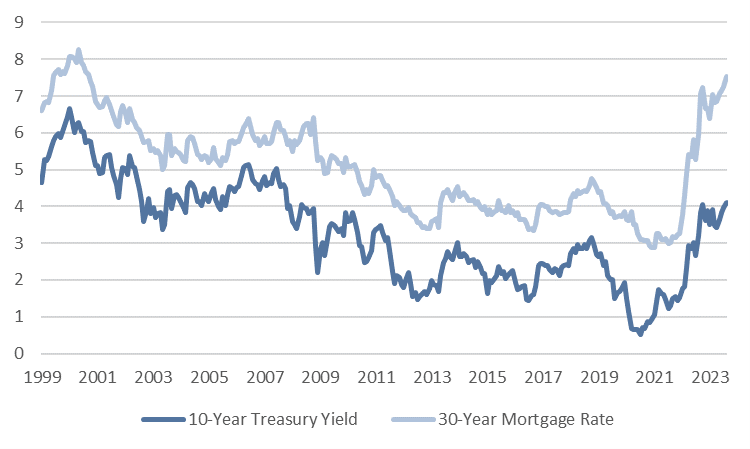Will Mortgage Rates Decline?
Last week...
- Equity markets continue to face headwinds as investors digest a “longer but not higher” mindset from the Fed.
- 12-month forward earnings per share estimates for the S&P 500 continue to move higher, reflecting the uptick in economic data that we’ve seen this quarter.
- The slowdown in China has been significant enough that Bloomberg Economics now forecasts it may never overtake the United States from a GDP standpoint.
Fig. 1: Mortgage and Treasury Rates

Single family housing provides an interesting perspective on the challenges facing the Fed as they attempt to navigate a soft landing in the US economy. The Fed’s rate hikes have yet to restore general price stability (2% inflation), but they have created huge distortions in the housing market.
Average 30-year mortgage rates jumped from 2.82% to 7.5% between January 2021 and September 2023, which makes a huge difference in monthly payments. The monthly principal and interest payment for a 30-year fixed-rate mortgage has gone up nearly 70% in 2.5 years, assuming the same mortgage value. This shift in financing cost has resulted in a collapse in transaction volume and buyer affordability.
There’s been some speculation that homebuyers (and their realtors) are rationalizing current mortgage rates with the assumption that they will be able to refinance to a lower rate in the near future. It is true that relief could come from a normalization of the spread between Treasury yields and mortgage rates.
The spread between the 10-Year Treasury Yield and 30-year mortgage rate generally averages 1.5-2%. It’s currently unusually high at 3.4%, so a normalization of that relationship would bring mortgage rates down to around 6%.
Market participants currently expect the 10-year Treasury yield to remain between 4-4.5% for the next five years. A 10-year Treasury yield of 4-4.5% plus a normalized mortgage spread of 1.5-2% implies an interest rate range of 5.5-6.5% on 30-year mortgages. It is hard to make a case, absent a crisis, that
mortgage rates will fall considerably lower than that range in the medium term.
Download Document
Download NowDisclosures & Important Information
Any views expressed above represent the opinions of Mill Creek Capital Advisers ("MCCA") and are not intended as a forecast or guarantee of future results. This information is for educational purposes only. It is not intended to provide, and should not be relied upon for, particular investment advice. This publication has been prepared by MCCA. The publication is provided for information purposes only. The information contained in this publication has been obtained from sources that
MCCA believes to be reliable, but MCCA does not represent or warrant that it is accurate or complete. The views in this publication are those of MCCA and are subject to change, and MCCA has no obligation to update its opinions or the information in this publication. While MCCA has obtained information believed to be reliable, MCCA, nor any of their respective officers, partners, or employees accepts any liability whatsoever for any direct or consequential loss arising from any use of this publication or its contents.
© 2025 All rights reserved. Trademarks “Mill Creek,” “Mill Creek Capital” and “Mill Creek Capital Advisors” are the exclusive property of Mill Creek Capital Advisors, LLC, are registered in the U.S. Patent and Trademark Office, and may not be used without written permission.